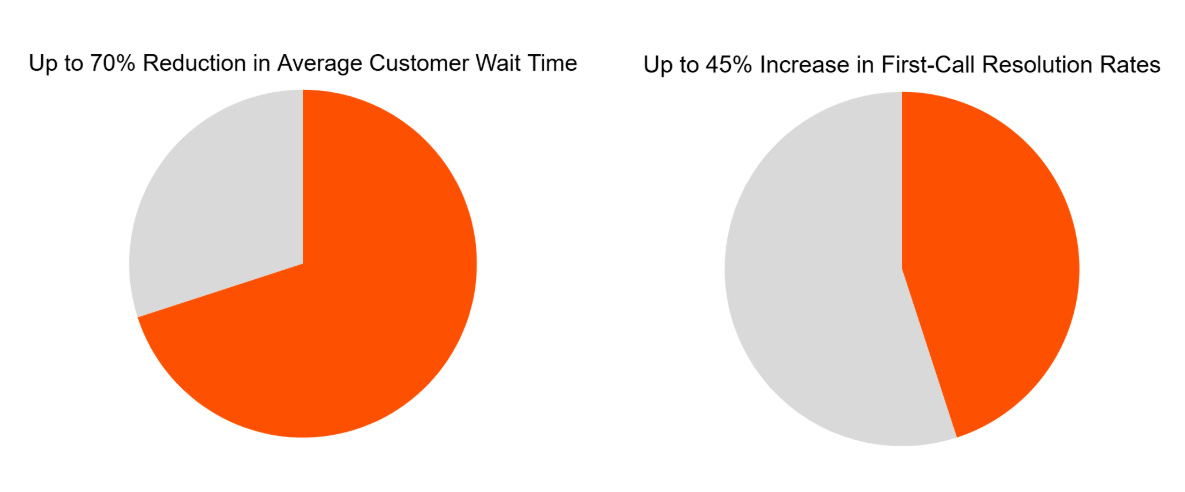The integration of artificial intelligence in call centers has moved from experimental to essential. Forward-thinking service businesses are discovering that AI implementation delivers measurable improvements in operational efficiency, cost reduction, and customer satisfaction—often within 3-6 months of deployment.
This comprehensive analysis examines the AI impact in call centers, including:
- Quantified impact of AI on call center operations and costs
- Customer satisfaction metrics that improve with AI integration
- How intelligent platforms streamline multi-level communications
- Why configurable AI solutions outperform rigid legacy systems
Primary Impact Areas of Using AI in Call Centers
| Impact Area | Improvement Range | Implementation Time | Cost Impact |
| Call Resolution Speed | 35-60% faster | 2-4 weeks | 25-40% cost reduction |
| Agent Productivity | 40-65% increase | 4-8 weeks | 30-50% efficiency gain |
| Customer Wait Time | 45-70% reduction | 1-3 weeks | 20-35% operational savings |
| First-Call Resolution | 25-45% improvement | 6-12 weeks | 15-30% cost decrease |
| After-Hours Coverage | 80-95% automation | 2-6 weeks | 50-75% labor savings |
AI Impact on Call Centers: Operational Efficiency Gains Through AI Integration
Intelligent Call Routing and Prioritization
AI-powered routing systems analyze caller intent, history, and urgency to connect customers with the most qualified agents. This eliminates the frustrating experience of multiple transfers while reducing average handle time by 35-50%.
Project-based businesses particularly benefit from AI’s ability to recognize complex, multi-phase job inquiries and route them to specialized teams equipped to handle contract negotiations, milestone tracking, and progressive invoicing discussions.
Automated Response and Resolution
Modern AI systems handle 60-80% of routine inquiries without human intervention. Common requests like appointment scheduling, status updates, and basic troubleshooting are resolved instantly, freeing agents to focus on complex project coordination and relationship building.
Cost Reduction Metrics and Financial Impact
Labor Cost Optimization
The most significant AI impact comes through strategic workforce optimization. Rather than replacing agents, successful implementations redeploy human resources to higher-value activities. Organizations typically see:
- 30-45% reduction in routine call handling costs
- 25-35% decrease in overtime expenses
- 20-30% improvement in agent retention rates
- 40-60% faster new agent onboarding
Operational Expense Reduction
AI systems reduce operational overhead through intelligent resource allocation. Peak-time staffing becomes more predictable, and off-hours coverage requires minimal human supervision. Project-based businesses report particular savings in after-hours emergency response, where AI handles initial triage before escalating to on-call technicians.
Customer Satisfaction Enhancement Through AI
Reduced Wait Times and Faster Resolution
Customer satisfaction scores improve dramatically when AI eliminates common friction points. Average customer wait times drop by 45-70%, while first-call resolution rates increase by 25-45%. This is particularly valuable for project-based businesses managing complex, multi-stakeholder communications.

Personalized Customer Experiences
AI systems maintain comprehensive interaction histories, enabling personalized service from the first contact. Customers no longer need to repeat project details or explain previous issues. This continuity is especially important for long-term projects requiring ongoing coordination between field teams, customers, and headquarters.
Implementation Strategy for Service Businesses
Configurable vs. Fixed AI Solutions
The key to successful AI implementation lies in choosing configurable platforms that adapt to your specific workflows rather than forcing your business to conform to rigid software limitations. Configurable AI solutions allow you to:
- Adjust call routing based on project complexity and team expertise
- Customize automated responses to match your brand voice
- Modify escalation protocols for different service categories
- Scale AI capabilities up or down based on seasonal demand
Integration with Existing Systems
Modern AI platforms offer 60+ different integrations that connect seamlessly with existing business tools. This modular approach means you can implement AI gradually without disrupting current operations or requiring complete system overhauls.
Training and Change Management
Successful AI adoption requires strategic change management. Teams need 2-4 weeks of training to understand new workflows, but the investment pays dividends through improved job satisfaction and reduced turnover. Agents report higher engagement when freed from repetitive tasks to focus on complex problem-solving and customer relationship building.
Why Intelligent Platforms Drive Better Results
Service businesses using intelligent, configurable AI platforms consistently outperform those relying on patchwork solutions or legacy systems. The difference lies in seamless integration across all communication channels—customer portals, mobile apps, automated notifications, and direct agent interactions.
Zuper’s intelligent platform exemplifies this approach by turning technology into a competitive advantage rather than an operational burden. With no-code workflows and intuitive interfaces, teams can configure AI behaviors without requiring extensive technical expertise or software engineering support.
The platform’s ability to streamline multi-level communications between customers, field teams, and headquarters eliminates the communication silos that plague traditional call center operations. Real-time visibility through customer portals and automated SMS updates keeps all stakeholders informed while reducing inbound inquiry volume.
Ready to see Zuper AI’s impact in call centers for yourself? Request a demo.



